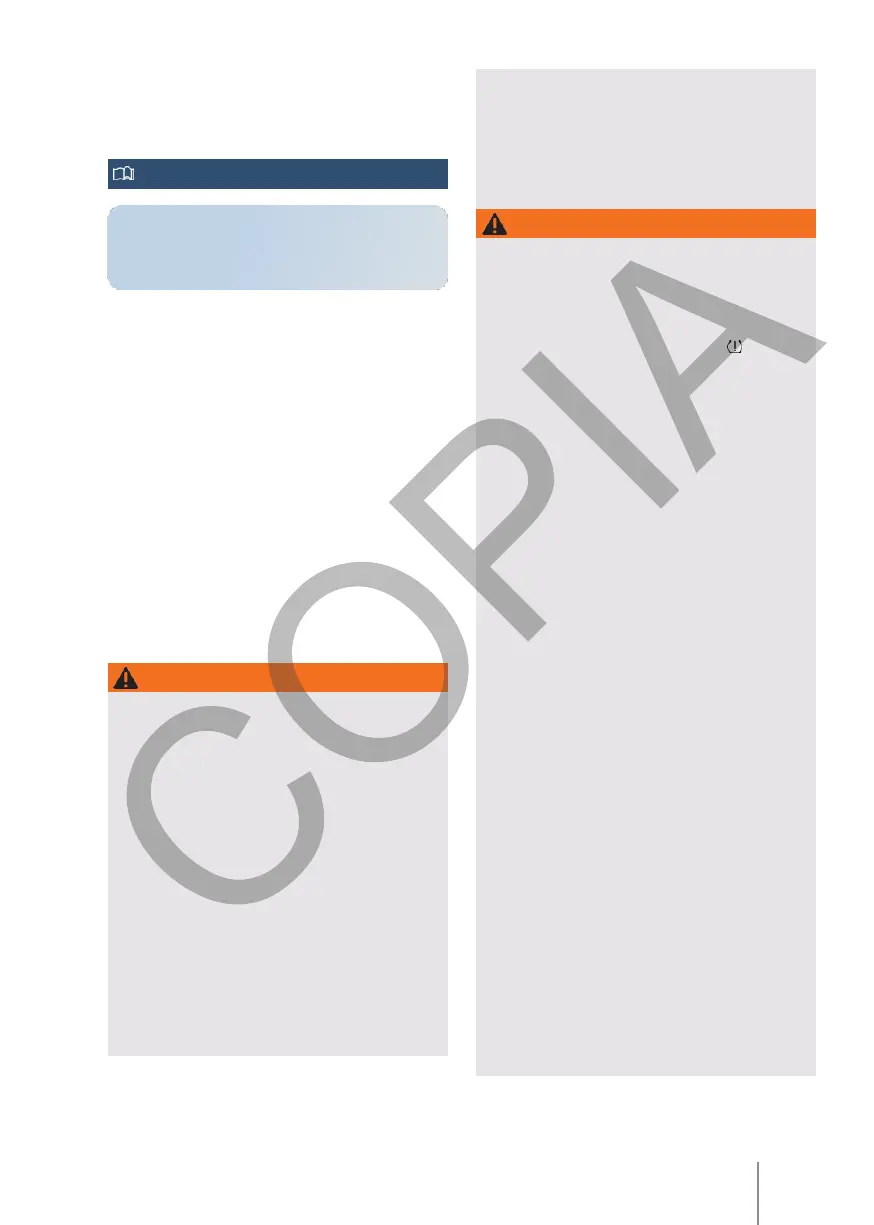If the tyre pressure is too low, adjust the tyre
pressure to the desired value.
The vehicle is mounted on the vehicle when cold.
→ p. 227.
•
Periodically check tyres for signs of wear or
damage.
•
Never exceed the maximum speed and load
capacity of the tyres fitted.
If the pressure is not the same in all tyres
If the tyres are too low, tyre damage or failure
could occur, loss of control of the vehicle could
lead to accidents, serious injury or death.
or death.
•
If the indicator light comes on, stop
immediately and check all the neu- matics →
page 227.
•
If the tyre pressure is not the same in all tyres
or is too low, it could increase tyre wear,
worsen tyre stability and increase the risk of
tyre damage.
The braking distance must be increased.
•
If the pressure is not the same in all tyres or is
too low, a tyre could suddenly fail or burst,
and the tyre could be damaged.
losing control of the vehicle.
•
The driver is always responsible for ensuring
that all tyre pressures in the vehicle are
correct. The recommended tyre pressure is
given in
on a sticker → p. 227.
•
The tyre monitoring system can only fulfil its
function if all tyres have the correct cold tyre
pressure.
•
Tyres shall always have a tyre pressure
appropriate to the load condition of the
vehicle.
→ p. 227.
•
Always inflate all tyres to the correct
pressure before setting off.
→ p. 227.
•
If the tyre pressure is too low, the tyre is
subjected to more flexing work and may
therefore heat up as much as it would if the
tyre were driven at too low a pressure.
the tread could come off, the tyre could burst
and you could lose control of the vehicle.
•
If the tyres are driven at high speed or with
excessive load, the tyres could become so hot
that they could burst and the tyre could lose
its grip.
control of the vehicle.
•
Excessive or insufficient tyre pressure reduces
the service life of the tyres and impairs the
vehicle's handling.
Introduction to the topic
The tyre monitoring system warns the driver if
the tyre pressure is too low.
The intelligent technology of the tyre control
system cannot overcome the limits imposed by the
laws of physics and only works within the limits of
the system. Improper handling of wheels and
tyres can cause sudden loss of pressure, tread
separation and even tyre blowout.
•
Check the tyre pressure regularly and always
keep to the specified values → page 227.
If the tyre is too low, the tyre could become
so hot that the tread could detach and the
tyre could burst.
•
Always maintain the correct tyre pressure
according to the tyre pressure sticker,
measured when the tyres are cold → p. 227.
•
Check the tyre pressure regularly when the
tyres are cold. If necessary, check the tyre
pressure regularly when the tyres are cold.
Wheels and tyres
Tyre
control systems
The following tyre control systems are available for
this vehicle:
Tyre control system
—
It monitors various parameters (e.g. rolling
circumference) of all four tyres during driving by
means of the ABS sensors (indirect
measurement).
The reference pressure of the tyre monitoring
system is the recommended pressure for the
factory-fitted tyres, measured when the tyres are
cold and the vehicle is fully loaded. The reference
pressure corresponds to the data on the tyre
pressure sticker → p. 227.
If the correct tyre pressure has been set for all
four tyres, the tyre monitoring system must be
readjusted → p. 222. This adapts the reference
pressure to the current tyre pressure.

